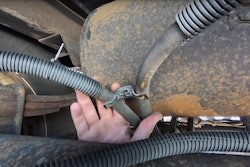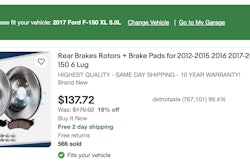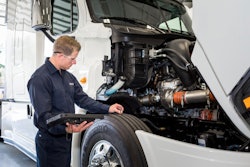There is no season for good maintenance but the transition to warmer weather does present challenges and opportunities to hone preventive practices.
Gene Jensen, Lubricants Trainer for Chevron Lubricants, joins Jason and Matt this week on CCJ's 10-44 to discuss the seasonal influence on several areas, and a few small steps fleets can take that might make a big difference.
Contents of this video
00:00 Fleet maintenance and seasonal changes00:55 A grease is three things
02:50 Determining the appropriate grease
03:34 The most important part of a grease
04:09 Ambient temperatures and engine oil
06:30 The worst thing you can do to an engine
07:03 The importance of dialing in on viscosity
08:23 Lower viscosity oils and fuel economy
This week's 10-44 is brought to you by Chevron Delo 600 ADF ultra low-ash diesel engine oil. It's time to kick some ash.
Jason Cannon
There's not a season for good maintenance, but the changing of temperatures is always an opportunity to be sure you're optimizing your maintenance.
Hey everybody. Welcome back to the 10-44, a weekly web episode from the editors here at CCJ. I'm Jason Cannon and my co-host on the other side is Matt Cole. There's really not a maintenance interval for the changing of seasons, but a swing in ambient temperature does present some challenges and some opportunities. The obvious scenario here is tires. When outside temps drop, there's generally a corresponding drop in PSI. While there's not a standard that says, "Every November you need to check your tires," it's one of those good rules of thumb to tuck away in the back of your head. But according to Gene Jensen, who's Chevron Lubricants' Lubricants Trainer, seasonal opportunities are not isolated to rubber.
Gene Jensen
If you back up and say, "We only use grease when we have to." It would be way better to have a fluid that flowed and cooled. Grease really doesn't do either one of those. We only use grease when we have to. Let's talk a little bit about what grease is.
A grease is three things. A grease is the base oil and that's the most important part, whether it's mineral or synthetic, but it's the most important part and the viscosity of that is also very, very critical here as we look at these things. That's the base oil.
Then we go to thickener. Thickener is kind of like how grandma makes gravy. How does grandma make gravy? She takes the drippings from the roast and she adds thickener, cornstarch or flour. We kind of do the same thing, and not all thickeners like one another so you got to be careful if do have to change greases for seasonality, and I'll talk about that in just a second. You got to be careful that the thickeners are... because they don't all work and play well together.
The last thing is the additives. We put in EP, which stands for extreme pressure. We put in a tackiness. A lot of people when they look at a grease, they like to go like that with their finger. I call that the pocket tackle meter.
But anyway, the other thing is Moly, and I'll say something here, and a lot of your subscribers, they may have big yellow equipment as well. And so Moly, in slow moving big yellow equipment is good, but in trucks Moly is slightly abrasive. So a bearing will actually, in my experience, will actually last longer if it doesn't have Moly in it, if it's in a wheel bearing. But if it's in a slow moving like in a bucket pin or something like that in a front end loader, and I realize that's not really your subscribers here, just as a contrast there. So Moly has its place in my opinion. But when we're talking about seasonality greases with that kind of as a basic background, the pumpability is a big deal.
Matt Cole
Fleet sometimes will jump between grease type based on whether a thicker grease will pump in colder climates. But Gene cautions against using pumpability as the determining factor in whether or not the grease is appropriate for the application.
Gene Jensen
In the wintertime, sometimes in the shop you can't get a number two grease to pump. And so what do we have to do? We have to go to number one grease for the wintertime. In the summertime you might want to go back. And so what's the difference? Well grandma used less thickener, or we use less thickener. So you want to be careful. You keep greases if you have to move on a seasonality basis between hot and cold is that you stay in the same family. In other words, the base oil is the same and the thickener type is the same. Just the amount of thickener is different.
Jason Cannon
The most important part of a grease is its base oil and its viscosity, not its color.
Gene Jensen
Color is very psychosomatic. I've had greases that are identical and the person, they hate the brown one, but they love the red one and color is only a dye. So don't let that set you sideways. And after a grease has worked for a while, it goes black, goes dark in color. So it's just basically a dye in there. So don't let that go yet. However, if the grease is gray, that usually means it's got Moly in it. So anyway, that's my little segment on grease.
Matt Cole
Ambient temps will have a significant effect on the engine oil, especially a startup.
Gene Jensen
The first number and it like 15-40. The first number is, by the way, W stands for winter. That's the cold side. So 15 is actually the oil in and of itself. The base oil in and of itself is, that's what the viscosity is. The second number is what it acts like at operating temperature. I'm going to say that one more time.
The first number is what it acts like because that's what it is at startup. And the second number is what it acts like at operating temperature. Now, oils in and of themselves, they can't be a 15-40, A 15 can't really also be a 40. So we put an additive in there. It's a thickener, it's a modifier. It's called the viscosity index improver. And what it does is it helps that oil thin out slower. As a basic understanding here is that 15, it acts like the first one at startup, it acts like the second one at operating. It does not thicken. It thins out slower because we put that additive in there.
Jason Cannon
One of the worst things you can do to an engine is something that every one of us does every single day, sometimes multiple times a day. Gene tells us what that is right after a word from 10-44 sponsor Chevron Lubricants.
Protecting your diesel engine and its after treatment system has traditionally been a double-edged sword. The same engine oil that is so essential to protecting your engine's internal parts is also responsible for 90% of the ash that is clogging up your DPF and upping your fuel and maintenance costs. Outdated industry thinking still sees a trade-off between engine and emission system protection and Chevron was tired of it. So they spent a decade of R&D developing a no compromised formulation. Chevron Lubricants developed a new ultralow ash diesel engine oil that is specifically designed to combat DPF ash clogging.
Delo 600 ADF with OmniMax technology cuts sulfate ash by whopping 60%, which reduces the rate of DPF clogging and extends DPF service life by two and a half times. And just think what you can do with all the MPGs you're going to add from cutting your number of re-gens. But Delo 600 ADF isn't just about after treatment. It provides complete protection, extending drain intervals by preventing oil breakdown. Before you had to choose between protecting your engine or your after treatment system. And now you don't. 600 ADF from Delo with OmniMax technology, it's time to kick some ash.
Gene Jensen
What's the worst thing you can do to an engine? And they come up with all kinds of answers and the answer really is, start it. That's the worst thing you can do is start it. Because all that oil's in the bottom. So relative to viscosity and seasonality and things like that is that in the morning when it's cold, especially in the wintertime which we're coming out of while this is being recorded, you want that oil to get up there as quickly as possible. So the smaller that first number is, the faster that oil gets up there and gets in there and stops the wear. Most wear happens in the first 30 seconds after you start an engine.
Matt Cole
With most engine wear occurring so early, Gene says that's why it's so important to dial in viscosity and be sure that the level of protection the oil can provide matches with the truck's operating conditions and duty cycle.
Gene Jensen
We need to adjust the viscosity to temperature. If you're in a real hot climate, then you probably need something a little more viscous. If you're in a really cold climate, you need something that's a little less. I remember I was in Fairbanks, Alaska and they had trucks going all over the place and they said, "What do you think about a synthetic viscosity 5W-40, very wide range?" And I said, I was there in the summertime and they said, I said, "Well, it depends on how cold and how hot it gets." And they said, "How's minus 45 degrees Fahrenheit for you?" I forgot where I was. But certainly the lower that first number is, the easier it is to start when it gets really cold and the less wear that you have.
The other thing is when we talk about viscosity, we move into the fuel economy discussion. And so here's my little silly story. Swimming is hard. It's hard, it's hard to swim. That's not an easy thing. But swimming in putty is harder, or swimming in mud is harder and it's because of the viscosity of the medium that you're swimming in. So the lighter that the oil is inside of that engine, the less push or viscosity that the parts have to work against so you get better fuel economy.
Jason Cannon
The current trend to see and more fleets opt for lower viscosity oils because that leads to higher fuel economy even if those fleets are nearly a decade behind OEM recommendations and that's likely to continue.
Gene Jensen
All right, so when you look at viscosity and fuel economy, what we've got going on is the trend is lower, absolutely. The trend is lower viscosity. An example, you move from 15-40 to 10W-30, you pick up a percent, percent and a half in fuel economy. The trend is going to continue to go lower and lower and lower. This year we're expecting to sell more 10-30 than 15-40. We do a lot of work with over the road trucks and over the road trucks, they've been recommending, the manufacturer's been recommending 10-30 since 2012 and 2013. That's been a long time.
In fact, they're moving to 5W-30 as we speak. Then the next step is 5-20 and then the next step is 0-20 in heavy duty diesel engines and it's all about fuel economy. What has to change? A lot of things have to change. The additives have to be better because you got to have, you've got that film and it's getting thinner and thinner, so you have to have better additives. The parts have to be better too. The taller, they polished the parts so there's more surface area that the lubricant's actually coming in contact with.
Jason Cannon
That's it for this week's 10-44. You can read more on ccjdigital.com and as always, you can find the 10-44 each week on CCJ's YouTube channel. And if you've got questions, comments, criticisms or feedback, please hit us up at [email protected] or give us a call at 404-491-1380. Until next week, everybody stays safe.











